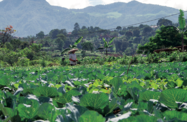Indonesia is stepping up efforts to become self sufficient in rice production while also building a safety net with imported stockpiles, though a decision by Thailand to scrap a key sales agreement briefly tore a hole in the net that Jakarta officials were left scrambling to repair.
The world’s third largest rice consumer has made significant progress in ensuring the security of its domestic rice supplies in recent years and is likely to achieve self sufficiency in production by the middle of this decade.
According to a report issued by the Australian Centre for International Agricultural Research in September, Indonesia has become more efficient at producing rice, increasing yields per hectare by 13% between 1985 and 2009. As a result, yields per hectare were at record levels last year, coming in at some 5.1 tonnes for every hectare harvested, well up on the global average of 4.3 tonnes, the report said. At least some of this increase stemmed from planting improved strains of rice and using better technology and sustainable farming practices, local media reported.
Though average yields are up, Indonesia still fell short of its harvest target of 66.8m tonnes of unmilled rice last year, with 66.4m tonnes collected from the 13.3m ha under cultivation. Indonesian officials hope production will rise further this year and have forecasted a harvest of 68m tonnes for 2011, with the country being self-sufficient by 2014.
Robert Zeigler, the director general of the International Rice Research Institute, believes that Indonesia can achieve its long-term goal. “Yes, definitely Indonesia could reach rice self-sufficiency by increasing its rice yield,” Zeigler said in early October. “They need to be able to increase the yield on the existing paddy field. They do not need to expand paddy fields and they do not need to cut down forest to produce rice in paddy fields.”
It was far better to lift output from fields already in use by implementing improved techniques and utilising existing irrigation and transport infrastructure, he said.
Until Indonesia achieves self-sufficiency in rice production, it will continue build up a 1m-tonne stockpile of grain sourced from abroad that is intended to cover any short-term scarcity in the market. However, the price Indonesia paid for its overseas-sourced rice could increase: in late September, Thailand pulled the plug on a major contract to sell Jakarta 300,000 tonnes of the grain, prompting Indonesia to cancel plans to buy 70,000 tonnes of rice from Thai exporters.
It is believed that Bangkok withdrew from the export deal, agreed to by the previous government, due to the lower tariff set for the sale. One of the election pledges of the new Thai government was to raise payments to local rice growers, which will necessitate a hike in prices to be passed on to overseas customers such as Indonesia.
So far this year, Indonesia has imported just over 577,000 tonnes of rice from Thailand, part of its stockpiling process, after having bought 277,305 tonnes of Thai rice in 2010.
Despite the agreement with Thailand falling through, Indonesian officials have been quick to reassure the public and markets that there will be no shortage of rice. At the end of September, the agriculture minister, Suswono, said Indonesia was not dependent on any one country for rice imports. “Indonesia can import rice from anywhere in the world,” he said.
On October 5, state logistics firm Perum Bulog announced it had struck a deal with Vietnam to import 700,000 tonnes of rice on top of 500,000 tonnes already agreed to. Sutaro Alimoeso, the managing director of state logistics firm Perum Bulog, said that Indonesia had the option of buying a further 300,000 tonnes of rice should it require it, with delivery timed for between March and April, and was also considering large-scale imports from India as part of a programme to build up reserves.
Though Indonesia has moved to secure its rice import needs, the decision by Thailand to push up prices to its farmers is expected to increase global costs. Some estimates suggest the Thai policy will result in a 20% jump in rice prices before the end of the year.
While this could impact Indonesia’s inflation rate, currently running at around 4.6%, it could also spur Jakarta to further develop local production and achieve self-sufficiency before the 2014 targeted deadline. If so, short-term higher prices could be a small cost to pay for future food security.

